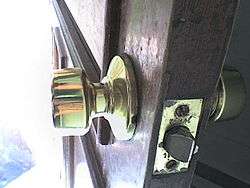Bored cylindrical lock
A bored cylindrical lock is a lock set which is installed by boring two circular holes in the door. Door handles may also use the same installation.

Installation

Two holes are bored, perpendicular to one another, into the door. The "face bore" is the larger hole which is bored into the door face and a smaller "edge bore" hole is bored into the door edge. The edge may require additional preparation to receive the latch assembly, typically by routing or chiseling a shallow mortise.[1] Some commercially-sold doors may come prepared to receive one or more bored cylindrical locks, such as entry doors, which typically require both a door knob and dead bolt.
In the United States, typically, the face bore is sized from 1.5 to 2.125 inches (3.81 to 5.40 cm) in diameter and is centered at 2.375 or 2.75 inches (6.03 or 6.99 cm) from the leading edge of the door. This distance is referred to as the "backset."[2] Other, less popular, backsets are at 3.75 and 5 inches (9.5 and 12.7 cm). Residential doors are normally prepared with a 2.375-inch (6.03 cm) backset and commercial doors have a 2.75-inch (7.0 cm) backset. The edge bore is typically centered on the edge.
History
The cylindrical lock was invented by Walter Schlage[3] in 1923.[4] The bored cylindrical lock arose from a need for a more cost-effective method of locking doors. The previous norm, the mortise lock, is a more complex device, and its higher manufacturing cost as well as its more labor-intensive installation make the bored cylindrical lock an ideal substitute, both in price and functionality. Because the mortise lock has a larger lock case, a larger and more complex volume must be removed from the door before it can be installed, but the mortise lock may offer additional functions compared to a cylindrical lock; for instance, the mortise lock may include a deadbolt in a single unit, while the cylindrical lock would require separate face bores for a deadbolt and doorknob.[5] The 1923 patent evolved from an earlier Schlage patent filed in 1920[6] for a lock whose installation required a face bore and surface rabbet, which simplified door preparation compared to a mortise lock.
Currently
The great majority of locks now in use on residences in North America are a variation of the cylindrical lock and are known as tubular chassis locks. Generally, they are not as strong as a cylindrical lock.
Images
References
- ↑ Gibson, Scott; Abram, Norm. "How to Install a Lockset". This Old House. Retrieved 12 April 2017.
- ↑ "What is Backset". Direct Door Hardware. Retrieved 12 April 2017.
- ↑ Derdak & Grant; Thomas Derdak; Tina Grant (2006). International Directory of Company Histories, Volume 82. University of California: St. James Press. p. 330. ISBN 1-55862-586-0.
- ↑ US granted 1674841, Schlage, Walter R., "Door Lock", issued 26 June 1928, assigned to Schlage Lock Co.
- ↑ "Basic Technical Fundamentals of Builders Hardware: Mortise, Bored and Auxiliary Locks". Sargent, an Assa Abloy Company. 2016. Retrieved 12 April 2017.
- ↑ US granted 1456041, Schlage, Walter R., "Door Lock", issued 22 May 1923, assigned to Schlage Manufacturing Company

